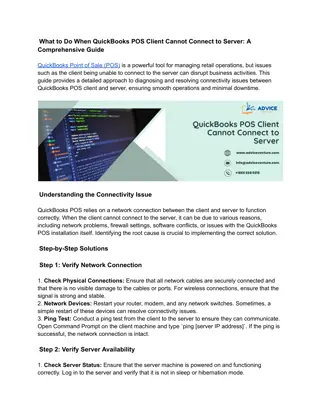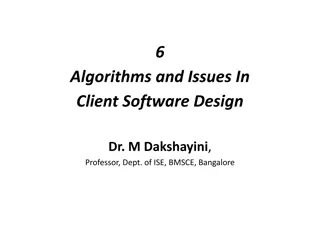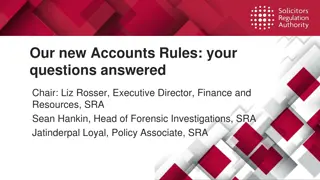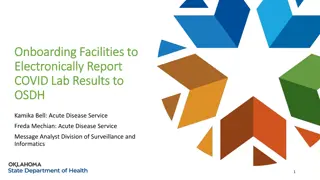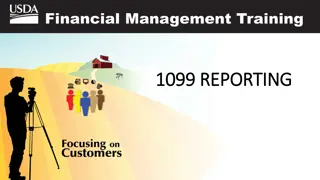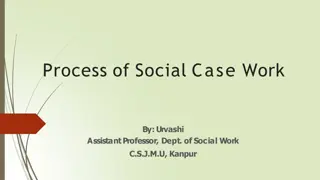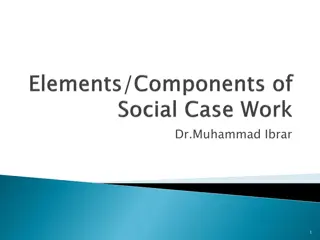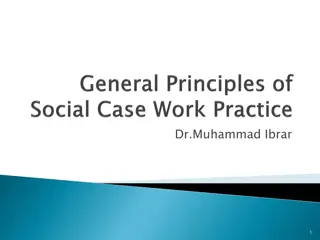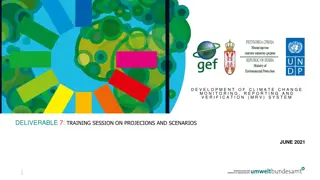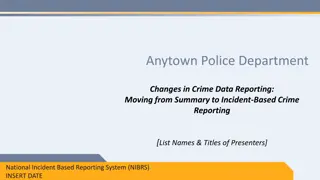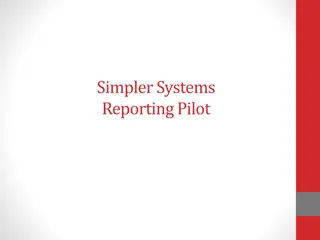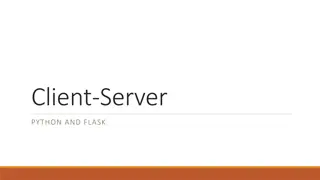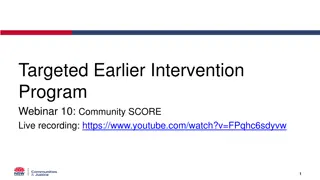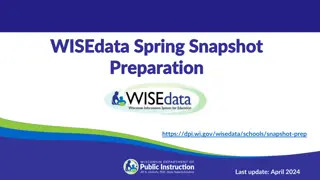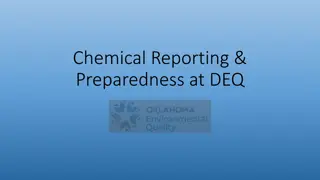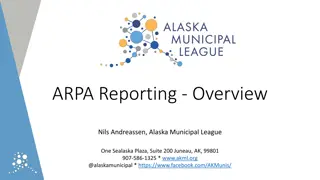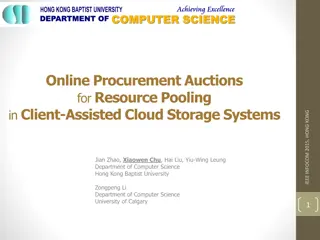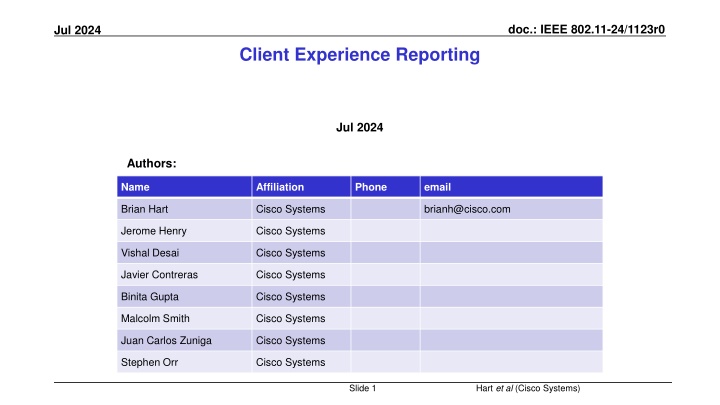
Enhancing Client Experience Reporting in IEEE 802.11 Networks
"Explore how to empower clients to provide feedback on their Wi-Fi experience in IEEE 802.11 networks, addressing potential gaps in current performance measures and ensuring optimal network settings for improved satisfaction. Authors from Cisco Systems present a comprehensive approach to enhancing client experience reporting, enabling a more client-centric network management strategy." (298 characters)
Download Presentation

Please find below an Image/Link to download the presentation.
The content on the website is provided AS IS for your information and personal use only. It may not be sold, licensed, or shared on other websites without obtaining consent from the author. If you encounter any issues during the download, it is possible that the publisher has removed the file from their server.
You are allowed to download the files provided on this website for personal or commercial use, subject to the condition that they are used lawfully. All files are the property of their respective owners.
The content on the website is provided AS IS for your information and personal use only. It may not be sold, licensed, or shared on other websites without obtaining consent from the author.
E N D
Presentation Transcript
doc.: IEEE 802.11-24/1123r0 Jul 2024 Client Experience Reporting Jul 2024 Authors: Name Affiliation Phone email Brian Hart Cisco Systems brianh@cisco.com Jerome Henry Cisco Systems Vishal Desai Cisco Systems Javier Contreras Cisco Systems Binita Gupta Cisco Systems Malcolm Smith Cisco Systems Juan Carlos Zuniga Cisco Systems Stephen Orr Cisco Systems Slide 1 Hart et al (Cisco Systems)
doc.: IEEE 802.11-24/1123r0 Jul 2024 Executive Summary Situation APs have many control knobs that affect the client experience APs optimize the setting of those knobs to maximize the client experience Using measures made by or offered to the APs Problem These measures may not capture all the dimensions that matter to clients Clients have no easy, standardized way to express their satisfaction / dissatisfaction with the 802.11 deployment . They don t have a seat at the table Solution Enable clients to be able to report their recent Client Experience to the network Slide 2 Hart et al (Cisco Systems)
doc.: IEEE 802.11-24/1123r0 Jul 2024 Situation AP has many control knobs at different time scales that affect the client experience Very Short Very long Long Short How often to trigger each client (&/or solicit BSR) How DL traffic is scheduled to clients How often to sound each client MCS/NSS/RU selection for DL and for UL Use of OFDMA / MU-MIMO / SU (and level of padding) AP positions (dense, sparse, coverage holes) Major feature support (11n/ ac/ ax/ be/.., 11r, ) Backhaul throughput / latency to intranet Backhaul throughput / latency to Internet Number of SSIDs Choice and change frequency of Primary channel / Channel width Choice and change frequency of AP TX power / Local TPC/TPE Coverage overlap between adjacent APs EDCA and MU EDCA parameters Medium feature support and enablement (FILS, TWT, R- TWT, P2P TWT) BSS Coloring Network contribution to time to associate Network contribution to time to roam BA/TWT/SCS/ agreements accepted / countered / rejected Use of BSS-wide mgmt. features like AP Add/Delete, Advertised TTLM as APs juggle tasks Use of per-STA mgmt. features like BTM to another AP, BTM+TTLM, BTM+Link Add+Delete to steer clients to clearer air Use of legacy features like Probe Response suppression, Association Rejection, ML Setup with fewer links offered, etc Slide 3 Hart et al (Cisco Systems)
doc.: IEEE 802.11-24/1123r0 Jul 2024 Situation AP has many measures for an excellent client experience Brief onboarding time Reliable DHCP, DNS, walled garden, application performance Ongoing assurance testing, Thousand Eyes Comprehensive wireless coverage throughout the deployment Channel utilization not too high Few co-channel APs, high throughput for offered load Low proportion of retries wrt tries Low latency, high power efficiency Especially for QoS TIDs, transmit buffers are shallow almost always Low latency High MCSs / NSSs / data rate with individual clients High system throughput / efficiency High degree of spatial reuse via AP/client power control SLAs expressed by SCS(QC) met (with margin) Brief outages during roaming Solid coverage overlap between adjacent APs Slide 4 Hart et al (Cisco Systems)
doc.: IEEE 802.11-24/1123r0 Jul 2024 Problem but these measures are incomplete: they don t include the client s own perspective of their experience What matters to the client: Connectivity (to intranet, Internet) Coverage, Throughput, Latency & Jitter Determined in turn by RSSI, interference level, contending Wi-Fi devices, deferring due to non-Wi-Fi emissions, etc Power efficiency Roaming experience In-device coexistence mitigation Privacy Other Example: stadium antennas (configured to 10deg beamwidth) have much weaker AP2AP RSSIs than AP2client RSSIs But the AP is not directly aware of many of these parameters: E.g., AP might aim for a minimum DL RSSI and UL RSSI everywhere, but only has intermittent access to DL RSSIs via 11k Beacon Report. And AP2AP RSSIs are an inferior substitute for these. Slide 5 Hart et al (Cisco Systems)
doc.: IEEE 802.11-24/1123r0 Jul 2024 Solution Overarching Concept Enable clients to be able to report their recent Client Experience to the network Thereby provide the system of APs (+compute) and clients with the information needed to improve the collective client experience Enable the network s ongoing trialing of alternatives to discover how to maximize the client experience Akin to Minstrel for rate selection, but with a much larger scope (i.e., revisit slide 3) The trialing can be: Manual, or Automatic, via closed loop optimization (using AI/ML etc), likely with guardrails Slide 6 Hart et al (Cisco Systems)
doc.: IEEE 802.11-24/1123r0 Jul 2024 Solution Option A: One Client Experience Score, plus areas for improvement Client can report a Client Experience Score ( Health Score ): e.g., 1 (all but unusable) to 255 (faultless) To accommodate the range of clients and how much effort they can allocate to determining a Client Experience Score, exactly how a client populates the value may be implementation dependent The overarching requirement is for the client to pick a way to calculate their Client Experience Score such that the client would be happier with a network that it describes by a higher score than by a lower score Client can also report area(s) for improvement by the network: E.g., 802.11 coverage/throughput, 802.11 latency/jitter, scanning and roaming, reliability, power efficiency, in- device coexistence, security/upper layers, backhaul, The union of areas defined should provide complete coverage of the network characteristics; and each area should be specific enough that the network can reasonably identify what kind of actions would mitigate the concern Slide 7 Hart et al (Cisco Systems)
doc.: IEEE 802.11-24/1123r0 Jul 2024 Solution Option B: Multiple Client Experience Scores, one per topic Example Client Experience Scores Example circumstances where client reports a worse metric Example circumstances where client reports a better metric 802.11 Coverage / Throughput Strong DL RSSI at strongest AP; high MCSs; TX buffers are mostly empty; and/or the client is operating at max PHY speed with high channel access duty cycle; no/minimal packet loss Weak DL RSSI at strongest AP; low MCSs; traffic arrival rate from client s upper layers is higher than the Wi-Fi transmission rate; the client s TX buffers are overflowing; many retries; long contention time; MSDU expiry reached (aka packet loss) 802.11 Latency/Jitter VO/VI packet loss; high VO/VI buffer depth (and/or MSDUs are dwelling a long time there) and/or VO/VI buffers are overflowing (any buffers, if mis- marked traffic?); codec in upper layers has downshifted to (much) lower than the highest quality; SCS(QC) SLA not met; bad ping time No/minimal VO/VI packet loss, low VO/VI buffer depth (and/or MSDUs are spending little time dwelling there; VO/VI buffers (almost) never overflow; codec in upper layers is operating at its highest quality Scanning and Roaming Roaming often; panic roams required; roaming recommendations (e.g., in Neighbor Report or ?BTM) not good, long dead times; often serving AP s RSSI is low; (often) not seeing two APs with RSSIs > -67 dBm Serving AP s RSSI is high so roaming not a consideration; or roaming occurs with minimal scanning and little downtime especially when QoS flows are active; no panic roams; client always sees two APs at > -67 dBm Reliability Periods of no frame transmission or no association;, missing multiple beacons in a row; multiple MSDUs in a row being expired out; received MPDUs being released to upper layers despite SN holes Continuous connectivity with no extended dropouts Power efficiency On battery and low MCS on TX/RX; long periods of idle RX or backoff; many retries Wall powered or transmit/active receive at high MCS; with few retries In-Device Coexistence Taking a long time to change PM bit, data rates drop markedly after each IDC absence, heightened retries, etc Client leaves and returns with minimal Wi-Fi downtime Security/upper layers Full connectivity Auth failure; EAP failure; no IP address; can t reach gateway; DNS not working; stuck at captive portal; no Internet connectivity to the usual places Backhaul IP/TCP/peer throughput much lower than wireless throughput IP/TCP/peer throughput similar to wireless throughput Slide 8 Hart et al (Cisco Systems)
doc.: IEEE 802.11-24/1123r0 Jul 2024 Solution Options A+B: Extra Details To calibrate/compare the information over time as the client mix evolves, it is preferred that: The Client Experience Score(s) be subject to quantitative guidelines, and/or The sender identifies itself via one or more of: device type/make/model/SW versions/chipset ID [1] The client feedback could be sent as: a response to an AP request or an unsolicited response or a conditional response to a conditional AP request ( send an unsolicited response whenever a Client Experience Score is above/below a threshold or changes by an amount above/below a threshold ) To help compare the client experience before-and-after a network behavioral change, the AP might request the Client Experience Score(s) calculation be reset For clients that cannot connect, the network may infer a CES of 0 Slide 9 Hart et al (Cisco Systems)
doc.: IEEE 802.11-24/1123r0 Jul 2024 Summary Benefit of Client Experience: Enable clients to be able to report their recent Client Experience ( health ) to the network such that the system of APs (+compute) and clients has the information needed to improve the collective client experience of the system Ongoing trialing of alternatives can occur, to discover how to maximize the client experience This provides clients with a seat at the table when decisions are being made on their behalf The goal of this process is for clients to collectively see a higher Client Experience score The proposal is very flexible for clients: What the client puts in is what the client gets out Slide 10 Hart et al (Cisco Systems)
doc.: IEEE 802.11-24/1123r0 Jul 2024 References [1] 24/0518, Troubleshooting Metric Follow Up , Jerome Henry et al, Cisco Systems Slide 11 Hart et al (Cisco Systems)
doc.: IEEE 802.11-24/1123r0 Jul 2024 Strawpoll 1 Do you prefer option 1 (1 Client Experience Score + list of areas for improvement) versus option 2 (multiple Client Experience Scores, one per area) Option 1 Option 2 Abstain Slide 12 Hart et al (Cisco Systems)
doc.: IEEE 802.11-24/1123r0 Jul 2024 Strawpoll 2 Do you agree to add the following text to the 11bn SFD: The 802.11bn amendment will define an exchange that allows non-AP STAs to rate their Client Experience of the current network Y / N / A Slide 13 Hart et al (Cisco Systems)
doc.: IEEE 802.11-24/1123r0 Jul 2024 Backup Slide 14 Hart et al (Cisco Systems)


